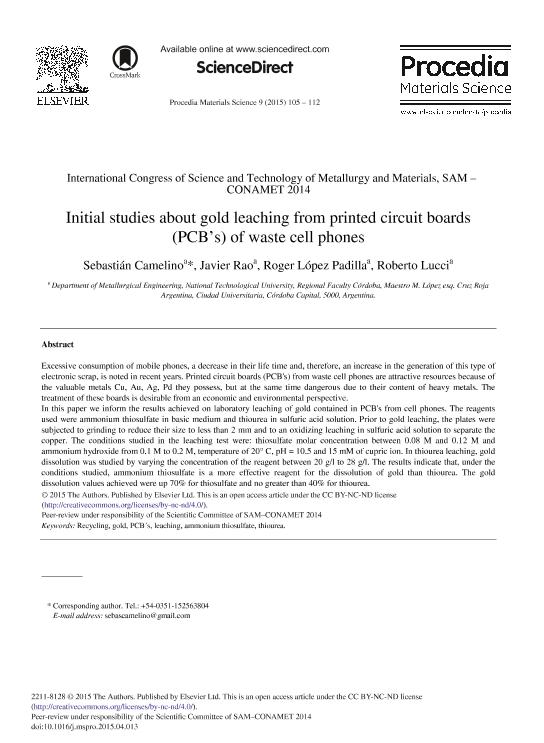Mostrar el registro sencillo del ítem
dc.contributor.author
Camelino, Sebastián Omar

dc.contributor.author
Rao, Javier
dc.contributor.author
López Padilla, Roger Marcio

dc.contributor.author
Lucci, Roberto Oscar

dc.date.available
2018-05-11T14:26:59Z
dc.date.issued
2015-02
dc.identifier.citation
Camelino, Sebastián Omar; Rao, Javier; López Padilla, Roger Marcio; Lucci, Roberto Oscar; Initial Studies about Gold Leaching from Printed Circuit Boards (PCB's) of Waste Cell Phones; Elsevier; Procedia Materials Science; 9; 2-2015; 105-112
dc.identifier.issn
2211-8128
dc.identifier.uri
http://hdl.handle.net/11336/44890
dc.description.abstract
Excessive consumption of mobile phones, a decrease in their life time and therefore, an increase in the generation of this type of electronic scrap, is noted in recent years. Printed circuit boards (PCB´s) from waste cell phones are attractive resources because of the valuable metals Cu, Au, Ag, Pd they possess, but at the same time dangerous due to their content of heavy metals. The treatment of these boards is desirable from an economic and environmental perspective. In this paper we inform the results achieved on laboratory leaching of gold contained in PCB´s from cell phones. The reagents used were ammonium thiosulfate in basic medium and thiourea in sulfuric acid solution. Prior to gold leaching, the plates were subjected to grinding to reduce their size to less than 2 mm and to an oxidizing leaching in sulfuric acid solution to separate the copper. The conditions studied in the leaching test were: thiosulfate molar concentration between 0.08 M and 0.12 M and ammonium hydroxide from 0.1 M to 0.2 M, temperature of 20° C, pH = 10.5 and 15 mM of cupric ion. In thiourea leaching, gold dissolution was studied by varying the concentration of the reagent between 20 g/l to 28 g/l. The results indicate that, under the conditions studied, ammonium thiosulfate is a more effective reagent for the dissolution of gold than thiourea. The gold dissolution values achieved were up 70% for thiosulfate and no greater than 40% for thiourea.
dc.format
application/pdf
dc.language.iso
eng
dc.publisher
Elsevier

dc.rights
info:eu-repo/semantics/openAccess
dc.rights.uri
https://creativecommons.org/licenses/by-nc-sa/2.5/ar/
dc.subject
Recycling
dc.subject
Gold
dc.subject
Pcb´S
dc.subject
Leaching
dc.subject.classification
Recubrimientos y Películas

dc.subject.classification
Ingeniería de los Materiales

dc.subject.classification
INGENIERÍAS Y TECNOLOGÍAS

dc.title
Initial Studies about Gold Leaching from Printed Circuit Boards (PCB's) of Waste Cell Phones
dc.type
info:eu-repo/semantics/article
dc.type
info:ar-repo/semantics/artículo
dc.type
info:eu-repo/semantics/publishedVersion
dc.date.updated
2018-05-09T14:08:42Z
dc.journal.volume
9
dc.journal.pagination
105-112
dc.journal.pais
Estados Unidos

dc.description.fil
Fil: Camelino, Sebastián Omar. Universidad Tecnológica Nacional. Facultad Regional Córdoba. Departamento de Ingeniería Metalurgica; Argentina
dc.description.fil
Fil: Rao, Javier. Universidad Tecnológica Nacional. Facultad Regional Córdoba. Departamento de Ingeniería Metalurgica; Argentina
dc.description.fil
Fil: López Padilla, Roger Marcio. Universidad Tecnológica Nacional. Facultad Regional Córdoba. Departamento de Ingeniería Metalurgica; Argentina
dc.description.fil
Fil: Lucci, Roberto Oscar. Consejo Nacional de Investigaciones Científicas y Técnicas; Argentina. Universidad Tecnológica Nacional. Facultad Regional Córdoba. Departamento de Ingeniería Metalurgica; Argentina
dc.journal.title
Procedia Materials Science
dc.relation.alternativeid
info:eu-repo/semantics/altIdentifier/doi/http://dx.doi.org/10.1016/j.mspro.2015.04.013
dc.relation.alternativeid
info:eu-repo/semantics/altIdentifier/url/https://www.sciencedirect.com/science/article/pii/S2211812815000140
Archivos asociados
